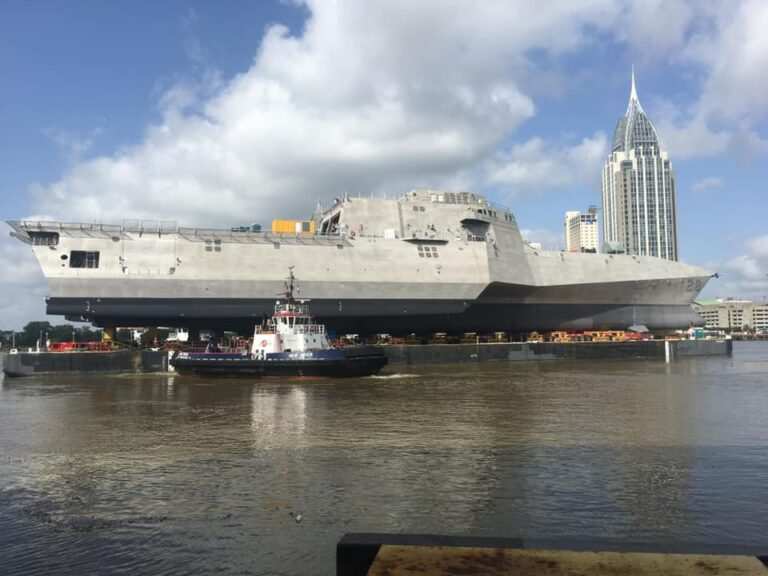This article was originally published by Radio Free Asia and is reprinted with permission.
A U.S. navy vessel arrived in Cambodia on Monday on the first visit of an American warship since 2016 as the United States seeks to improve defense ties with the Southeast Asian country amid concern that China is setting up a de-facto naval base there.
The USS Savannah (LCS 28) is staying for five days, until Dec. 20, at the Sihanoukville Autonomous Port, some 20 kilometers (12.5 miles) from Ream naval base where two Chinese navy ships have been docked for months.
The Independence-class littoral combat ship with more than 100 crew members has been on a routine underway, or ship-to-ship, operation in the South China Sea, according to the U.S. Pacific Fleet.
Cambodia’s Ministry of Defense said the port call – made at the request of the U.S. – “aims to strengthen and expand friendship and promote bilateral cooperation between Cambodia and the United States.”
The commander of the U.S. Indo-Pacific Command, Adm. Samuel Paparo, is taking part in the visit, which will include a bilateral meeting with the commander of the Ream base as well as an athletic competition between the Cambodian crew and the ship’s crew, a ministry statement said.
“The visit is highly symbolic as the U.S. is trying to rebuild defense relations again with the Cambodians, especially with the new Cambodian leadership in place,” said Rahman Yaacob, a research fellow at the Lowy Institute in Sydney, Australia.
Cambodia’s veteran strongman Hun Sen stepped down as prime minister in 2023 and was succeeded by his son, Hun Manet.
Yet the USS Savannah, like all other non-Chinese ships, has not been given access to Ream, which is undergoing a final phase of development before being transferred to the Cambodian navy. Sources say it is near completion.
Among the new structures is a deep-draft pier that can accommodate warships much larger than the USS Savannah.
“The Cambodians must have informed the Americans that works on the pier and other facilities for foreign warships are still in progress,” said Rahman, who has recently done research on the Ream base.
“The two Chinese warships at Ream are there to train Cambodian naval personnel and also to test the facilities,” Rahman told Radio Free Asia.
“Once the works are completed and handed over, Ream will be opened to all navies,” he said, citing information from Cambodian sources.
De-facto naval base
Cambodia has repeatedly denied that the Chinese military would gain a permanent foothold here, saying that would be against its constitution.
Still, there are concerns among U.S. defense circles that Beijing is setting a precedent with the Ream naval base, which is close to the disputed South China Sea and its shipping lanes.
A senior U.S. defense official, speaking to RFA on the condition of anonymity, said that even though Ream is unlikely to boost China’s capabilities in the South China Sea greatly, “we are worried about the precedent of China establishing bases overseas.”
With a long-term rotational presence and privileged access, China has formed a de-facto naval base in Ream.
“We are not in the position to undo that,” said the official.
The U.S. has long complained about the lack of transparency in the Ream project. The issue has added to recent frictions in relations with Cambodia.
Cambodia suspended an annual joint military drill, called the Angkor Sentinel, with the U.S. in 2017. U.S.-funded facilities at Ream were demolished in 2020.
In 2021, the U.S. canceled a scholarship for Cambodian citizens to enroll in the West Point military academy, Hun Manet’s alma mater, because of “weak cooperation in several areas of traditional bilateral military engagement.”
Washington has also criticized Phnom Penh for human rights violations and the repression of the political opposition.
Bilateral ties began warming this summer, after a visit by U.S. Defense Secretary Lloyd Austin to Phnom Penh. The two countries agreed to restart military exercises, and accept Cambodian students at West Point, but when and how are to be decided.
The U.S. and like-minded countries should continue to engage Cambodia to counter China’s rising influence in the region, said Rahman, who said that Ream, first of all, would provide China with an undeniable advantage in intelligence gathering against other states.
Vietnam, Cambodia’s neighbor which has a comprehensive strategic partnership with the U.S., is worried about the radar system at Ream, said Rahman.
“The air radar system could reach Ho Chi Minh City and Chinese personnel running it may monitor Vietnamese air traffic in the southern part of Vietnam,” he said.

